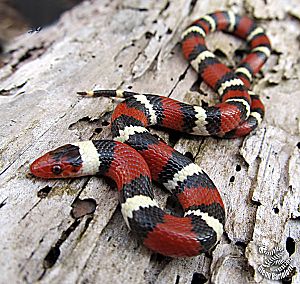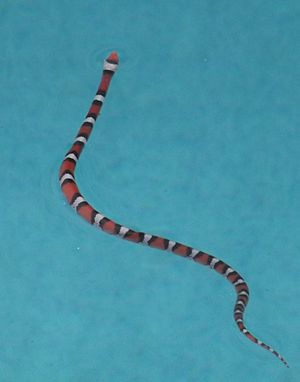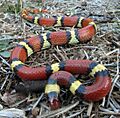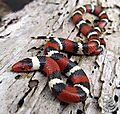Scarlet kingsnake facts for kids
Quick facts for kids Scarlet kingsnake |
|
|---|---|
 |
|
| An adult Scarlet Kingsnake in Florida | |
| Scientific classification | |
| Genus: |
Lampropeltis
|
| Species: |
elapsoides
|
| Synonyms | |
|
|
The scarlet kingsnake or scarlet milk snake (Lampropeltis elapsoides) is a type of kingsnake. You can find it in the southeastern and eastern parts of the United States. Like all kingsnakes, they are not venomous. This means they are not dangerous to people.
These snakes live in many places. They like pine forests, wet woodlands, and open grassy areas. You might also find them in gardens or even swimming pools. This often happens in the spring. For a long time, people thought scarlet kingsnakes were a type of milk snake. But scientists now know they are their own special kind of snake.
Scarlet kingsnakes are usually small. They are the smallest kingsnakes. Most adults are about 40 to 50 centimeters (16 to 20 inches) long. The longest one ever found was 68.4 centimeters (27 inches). Baby scarlet kingsnakes are very tiny. They are only about 8 to 18 centimeters (3 to 7 inches) long when they hatch.
Contents
What's in a Name?
The name Lampropeltis comes from old Greek words. Lamprós means "shiny" and peltas means "shield." This name describes their shiny scales.
The second part of their name, elapsoides, comes from a Greek word for coral. This is because the scarlet kingsnake looks a lot like the eastern coral snake. Coral snakes are very venomous. Scarlet kingsnakes live in some of the same areas as coral snakes. But scarlet kingsnakes also live much farther north.
How to Identify a Scarlet Kingsnake
Scarlet kingsnakes have bright colors. They have bands of black, red, white, and yellow. These colors help them look like the dangerous coral snake. This is a trick called Batesian mimicry. It helps keep predators away.
There are rhymes to help tell them apart from coral snakes. One popular saying is: "Red on yellow, kill a fellow; red on black, venom lack." This means if the red bands touch yellow bands, it's a dangerous coral snake. If the red bands touch black bands, it's a harmless snake like the kingsnake. For snakes found east of the Mississippi River, you can also look at their snout. Scarlet kingsnakes have a red snout. Eastern coral snakes have a black snout.
When scarlet kingsnakes are born, they have white, black, and red bands. As they get older, some of their white bands turn yellow. The yellow color can be light lemon, bright school-bus yellow, or even orange like a tangerine or apricot. This color change happens over their first three years. As they get even older, the yellow bands might get a bit darker.
Scarlet Kingsnake Habits
Scarlet kingsnakes are shy snakes. They are mostly active at night. They also spend a lot of time underground or hidden. This is why people don't see them very often. They are also great climbers.
You might find them hiding under loose bark on old pine trees. They love to hide there, especially in spring or when it rains a lot. They also hide under decaying wood. They hunt for their favorite foods in these places. They mostly eat small snakes and lizards, especially skinks. Baby scarlet kingsnakes really love to eat tiny ground skinks.
Scarlet Kingsnakes in Movies
A scarlet kingsnake was used in the 2006 movie Snakes on a Plane. It played the part of a coral snake in the film.
Images for kids






